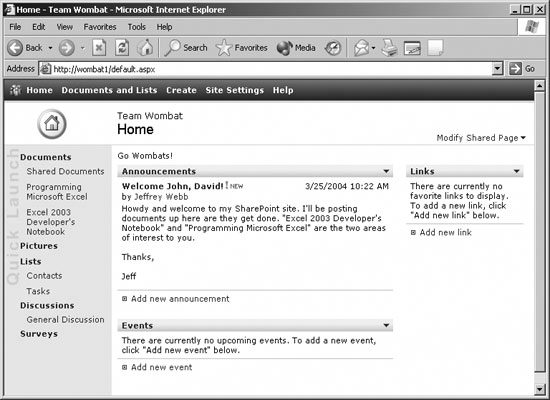Section 2.1.Get SharePoint Services
|
2.1. Get SharePoint ServicesIf you don't have SharePoint Services, you need it. I don't care if you work alone from your home office (as I do). SharePoint is too useful to pass up and it's free ...well, kind of. SharePoint Services are actually part of Windows 2003 so if you have Windows Server 2003 already, you can download the installation from Microsoft and install it fairly easily. If you don't have Windows Server 2003, you can sign up for a free 30-day trial though one of the SharePoint hosting providers. These third parties are a lot like the web hosting services you can find on the Internet. You get an account with some space on their server. You can administer your site yourself through a web-based interface, and after the free trial period, they'll bill you monthly. Note: Don't confuse Windows SharePoint Services with SharePoint Portal Server. SharePoint Services are the underlying components that SharePoint Portal Server is built on; and while the services are free, the portal is fairly expensive with per-user licensing. 2.1.1. How to do itI recommend you use the 30-day free trial of SharePoint before installing it on Windows 2003. There are several reasons for this:
Then, if you like it, go ahead and put it on your server. To get a free SharePoint site:
If everything goes correctly, you'll get a new SharePoint site that looks something like Figure 2-1. Note: Many of the new Excel features touch SharePoint in some way. Often SharePoint isn't absolutely required, but things are easier if you have access to it. Figure 2-1. Voila! A free SharePoint site courtesy of Apptix At this point, you can move on in the notebook to experiment with sharing workspaces and lists or you can just mess around with your new SharePoint site for a while, changing its main page (click Modify Shared Page), adding users (click Site Settings Note: Code used in this chapter and additional samples are found in ch02.xls. Hey, you're back! OK, to install SharePoint on Windows Server 2003:
Once installation completes, your server will provide a default web site similar to what is shown in Figure 2-2. Figure 2-2. SharePoint creates a default site on your server (this is mine) 2.1.2. How it worksIf you look on your server after installing SharePoint, you'll have a very hard time finding exactly where Default.aspx in Figure 2-2 is coming from. SharePoint installs that web site in the C:\Program Files\Common Files\Microsoft Shared\Web Server Extensions\60\TEMPLATE\1033\STS folder by default. If you look at Default.aspx in Notepad, you won't see any of the content (I won't even bother to show the HTML for that page hereit's not very informative). Where's the content? SharePoint puts most of it in a SQL database. If you don't have SQL Server on your system when you install SharePoint, SharePoint installs the Microsoft SQL Data Engine (MSDE), which is a stripped-down version of the SQL runtime. MSDE lets applications, such as SharePoint, create and access SQL databases. The web pages you see at your SharePoint site are Active Server .NET Pages (ASP.NET in Micro-speak). Those pages are little more than templates for the content retrieved from the SQL database. ASP.NET is part of the .NET Framework, and it runs under the Microsoft Internet Information Service, 6.0 (IIS 6.0). See Figure 2-3. Figure 2-3. The many layers of a SharePoint web site If your server was already hosting ASP.NET web sites, SharePoint takes over. You'll need to take special steps to host other web sites on your SharePoint Server. Web server administration and ASP.NET programming are enormous topics. If you're interested, I wrote an 850 page book on the subject last year. The beauty of using SharePoint, is that you don't need to read that long book. SharePoint creates any new ASP.NET web pages you need and populates them with data from SQL. You create new pages, sub-webs, documents, etc., through SharePoint's web-based interface. 2.1.3. What about...
|
|
EAN: 2147483647
Pages: 133
 Manage Users), adding a welcome announcement (click Add new announcement), and posting your vacation pictures (click Pictures
Manage Users), adding a welcome announcement (click Add new announcement), and posting your vacation pictures (click Pictures